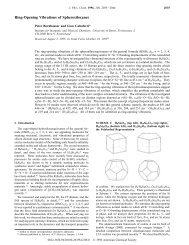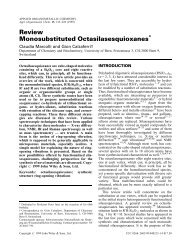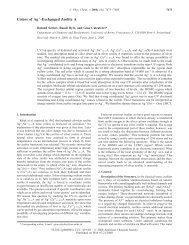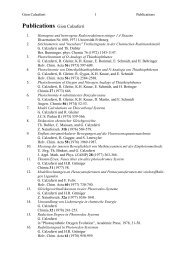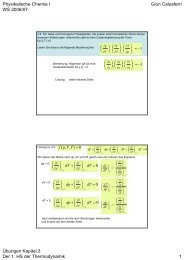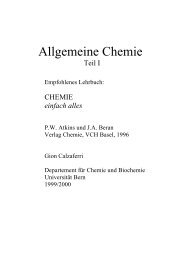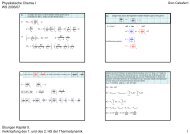Photonic antenna system for light harvesting
Photonic antenna system for light harvesting
Photonic antenna system for light harvesting
You also want an ePaper? Increase the reach of your titles
YUMPU automatically turns print PDFs into web optimized ePapers that Google loves.
Fig. 17 Absorption (solid) and emission spectra (dotted) of Py z and<br />
Ox z in zeolite L. The dashed lines show the transmission of the Schott<br />
DAD 8-1 interference filter and the Schott OG 515 cut-off filter.<br />
Fig. 18 Photographic image of the fluorescence of dye-loaded zeolite L<br />
layers upon monochromatic irradiation at 485¡5 nm and observation<br />
through a 500 nm cut-off filter. 1 and 7 are references loaded with Py z<br />
and Ox z only (occupational probability 1.4610 22 ). 2–6 contain a 1 : 1<br />
mixture of Py z and Ox z with the following occupational probabilities<br />
<strong>for</strong> each dye: 2, 6.8610 24 ; 3, 3.4610 23 ; 4, 6.8610 23 ; 5, 1.4610 22 ; 6,<br />
2.8610 22 . This is a pre-publication version of a figure to be included in<br />
a <strong>for</strong>thcoming work tentatively titled Advances in Photochemistry<br />
Volume 27 edited by D. C. Neckers, to be published in 2002. Copyright<br />
# 2001 John Wiley & Sons Inc. All rights reserved.<br />
absorption and the emission spectra of Py z and Ox z are<br />
plotted in Fig. 17.<br />
With a 1 : 1 mixture of the two dyes we can observe the<br />
energy transfer from the Py z donors to the Ox z acceptors very<br />
clearly. The seven luminescent samples shown in Fig. 18 consist<br />
of zeolite L crystals of 300 nm average length containing<br />
different amounts of Py z and Ox z . In all cases Py z was<br />
specifically excited at 486.7¡5 nm.<br />
Reference samples 1 and 7 contain only Py z or Ox z ,<br />
respectively. The other samples are 1 : 1 mixtures of the two<br />
dyes with increasing occupational probability. We can calculate<br />
the following mean donor–acceptor distances: 2, 187 A˚ ;<br />
3, 109 A˚ ; 4, 87A˚ ; 5, 69A˚ ; 6, 55A˚ . The Förster radius <strong>for</strong> Py z<br />
to Ox z energy transfer in a medium of refractive index of 1.4 is<br />
about 70 A˚ , based on the Py z /Ox z spectral overlap which is<br />
1.5610 213 cm 3 M 21 . In sample 2 we observe mainly the green<br />
luminescence of Py z , which means that the dyes are too far<br />
apart <strong>for</strong> Förster type energy transfer. The yellow colour of 3 is<br />
due to a mixture of green and red luminescence which means<br />
that energy transfer is significant. The energy transfer becomes<br />
more and more dominant, and by sample 6, the red luminescence<br />
of the Ox z is dominant.<br />
One would expect that the colour of the samples 2–6 in<br />
diffuse reflection mode to be the same since there is a 1 : 1<br />
mixture of the two dyes in all cases. This, however, is not<br />
observed because of the high concentration of dye molecules<br />
inside the zeolite. If the concentration of dye molecules inside<br />
the zeolite channels is high enough, a saturation effect is<br />
observed, i.e. <strong>light</strong> of specific wavelengths is totally absorbed<br />
and this changes the absorption spectrum as is shown in<br />
Fig. 19. There<strong>for</strong>e the visual colour of the different samples<br />
observed (as diffuse reflection) changes from yellow to red with<br />
increasing loading.<br />
10 J. Mater. Chem., 2002, 12, 1–13<br />
Fig. 19 Calculated saturation effect <strong>for</strong> a 1 : 1 mixture of Py z and Ox z .<br />
This effect changes the visual colour of the material.<br />
A similar experiment can be per<strong>for</strong>med to show energy<br />
migration. One can modify Py z -loaded zeolite L crystals with,<br />
on average, one Ox z molecule at both ends of each channel.<br />
By varying the occupational probability of Py z , and thus the<br />
mean distance between the Py z molecules, the energy migration<br />
efficiency can be varied. If energy migration is efficient, the<br />
electronic excitation energy will be trapped at the crystal endings<br />
by the Ox z molecules and the red emission of Ox z molecules<br />
will be visible. If, however, the energy migration is not very<br />
efficient, the green emission of the Py z molecules will dominate.<br />
5.2 Pigments<br />
A promising field with potential <strong>for</strong> industrial application is the<br />
use of dye-loaded zeolites as pigments. 55 The encapsulation of<br />
dyes in zeolite L leads in general to a substantially increased<br />
stability of the organic molecules. The matrix protects them<br />
from oxidative agents and other reactive species and the spatial<br />
constraints can eliminate photoisomerisation reactions. Additionally<br />
the processing properties of such pigments only depend<br />
on the zeolite surface, which can be tuned to a large extent, and<br />
not on the specific dye characteristics.<br />
The use of highly fluorescent dyes leads to much brighter<br />
colours. In particular, the xanthene dyes (Ox z ,Py z , PyGY z ,<br />
PyB z ) act as optical brighteners because the fluorescence in the<br />
visible region can be initiated by absorption in the UV-region<br />
of the spectrum. By the use of only two different dyes a large<br />
palette of different colours can already be generated (see<br />
Fig. 18). New interesting colour effects can be controlled via<br />
the energy transfer, saturation, and re-absorption phenomena<br />
in these materials. Applying the closure and stopcock<br />
molecules discussed in section 4.1 allows fine tuning of the<br />
specific properties of the pigments.<br />
5.3 Colour-changing medium<br />
A LED-display consists of a matrix of contacts made to the<br />
bottom and top surfaces of each <strong>light</strong> emitting element, or<br />
pixel. To generate a full-colour image, it is necessary to vary the<br />
relative intensities of three closely spaced, independently<br />
addressable pixels, each emitting one of the primary colours<br />
of red, yellow or blue. Several techniques have been proposed<br />
<strong>for</strong> producing the three colours in each pixel. One method is<br />
the use of a single blue or ultraviolet LED to pump organic<br />
fluorescent wavelength converters, also known as colourchanging<br />
media (CCM), as illustrated in Fig. 20. 56<br />
Fig. 20 Scheme of a pixel <strong>for</strong> generating full colour. The green and red<br />
colours are generated by trans<strong>for</strong>ming the emitted blue or UV-<strong>light</strong><br />
from the LEDs with the help of colour-changing media.





